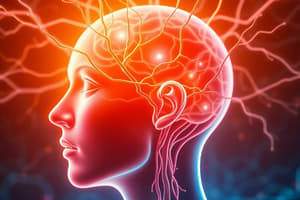Podcast
Questions and Answers
What is the result of intense emotions or a lowering of the physiological threshold?
What is the result of intense emotions or a lowering of the physiological threshold?
- Hyper-aesthesia (correct)
- Hypoacusis
- Hypo-aesthesia
- Delirium
What is the condition in which a person may see colours as very bright and intense?
What is the condition in which a person may see colours as very bright and intense?
- Hypomanic episode (correct)
- Depressive disorder
- Migraine
- Anxiety disorder
What is the feature of delirium that affects sensory acuity?
What is the feature of delirium that affects sensory acuity?
- Raised threshold for all sensations
- Hypo-aesthesia
- Defect of attention (correct)
- Increased sensitivity to noise
What is the condition in which everything is black or all foods taste the same?
What is the condition in which everything is black or all foods taste the same?
What is the result of a lowering of the physiological threshold?
What is the result of a lowering of the physiological threshold?
What is the condition in which a person may see roof tiles as a brilliant flaming red?
What is the condition in which a person may see roof tiles as a brilliant flaming red?
What is the condition in which even day-to-day noises are magnified to the point of discomfort?
What is the condition in which even day-to-day noises are magnified to the point of discomfort?
What is the importance of speaking to the delirious patient?
What is the importance of speaking to the delirious patient?
Flashcards are hidden until you start studying
Study Notes
Changes in Intensity: Hyper- and Hypo-aesthesia
- Hyperaesthesia: increased intensity of sensations due to intense emotions or lowered physiological threshold
- Examples of hyperaesthesia: seeing roof tiles as brilliant flaming red, hearing door closing as a clap of thunder
- Associated conditions: anxiety and depressive disorders, hangover from alcohol, migraine
- Hyperacusis: increased sensitivity to noise, even day-to-day noises, causing discomfort
Factors Affecting Sensory Perception
- Emotional state: hypomanic, epileptic aura, or under the influence of LSD can lead to bright and intense colours
- Normal emotions: intense emotions like religious fervour or romantic love can also cause increased sensory perception
Hypo-aesthesia
- Hypoacusis: decreased sensitivity to sound, often seen in delirium
- Causes of hypoacusis: raised threshold for all sensations, defect of attention, and attentional deficits
- Importance of speaking to delirious patients: slowly and louder than usual to compensate for hypoacusis
- Associated disorders: depression, attention-deficit disorder
- Other affected senses: visual and gustatory sensations may also be lowered in depression
Studying That Suits You
Use AI to generate personalized quizzes and flashcards to suit your learning preferences.




